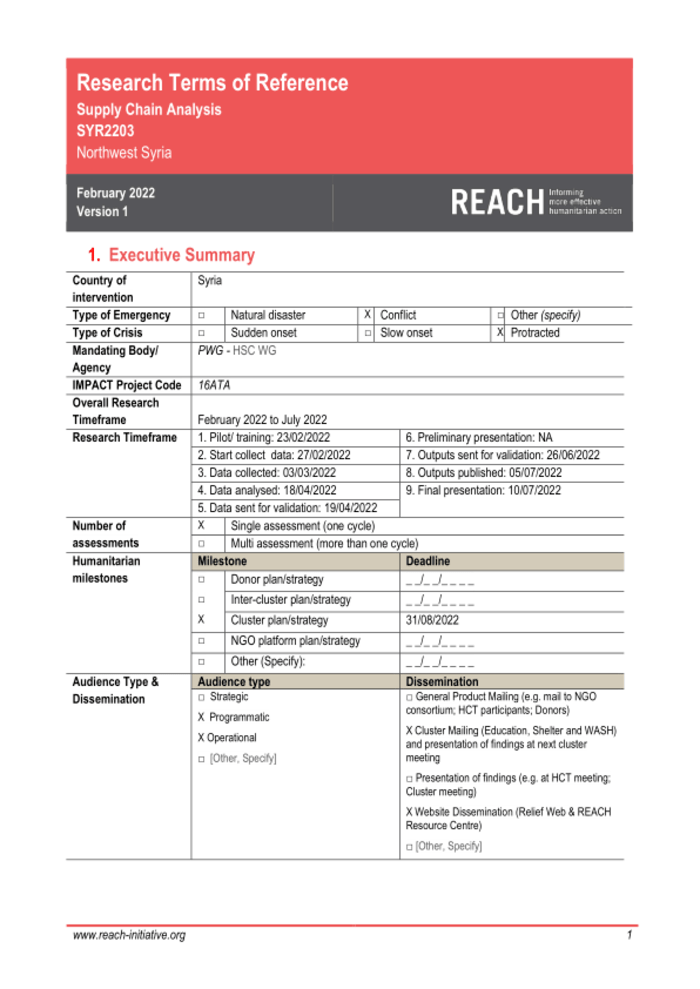2. Rationale
2.1 Background
The ongoing conflict, along with recurring drought conditions, has damaged pre-existing market structures in Syria. A decreased productive base, employment collapse (especially in the trade sector), a lack of income-generating opportunities, rising inflation, and the depreciation of the Syrian pound are all symptoms of the ongoing crisis. In this framework, some humanitarian actors have been transitioning away from emergency programming and towards recovery approaches that utilise market systems, including localization of activities (e.g procurement) to support local market functionality, and the use of CVA programming.
Currently, the NWS humanitarian supply chain is heavily dependent on items imported from Turkey, particularly, supply chains related to in-kind assistance such as food baskets, non-food item (NFI) kits, emergency shelter repair kits (ESKs), hygiene kits, and other common in-kind assistance packages recommended by the UN Cluster system. This dependency on imported humanitarian assistance continues to present a significant risk to the overall response should transshipment be disrupted by the expiration of the UN Cross Border Resolution, and if the borders close, this will result in problems to the supply chains, increasing prices, and reduced products availability. In 2020, the NGO Forum established the Procurement Working Group (PWG) to plan for a more sustainable commercial supply chain and in their assessment in 2021, the PWG launched a baseline study for NGOs’ procurement capacity. The study conclusion shows that after Food Security, SNFI and Wash sectors represented the largest volume of cross-border transshipped in-kind assistance in 2020.
The NWS local markets are functional, yet the humanitarian actors started to shift from emergency to preparedness planning, and one of the suggested approaches is to increase the scale-up of CVA to reduce in-kind assistance given the uncertainty around the future cross border voting. In the HSC WG strategic objectives, the working group highlights the need to identify solutions to increase local procurement in order to reduce the dependency on transshipment. The HSC WG also recommended the adoption of CVA interventions, and the implementation of further assessments to explore supply chains in local markets in relation to in-kind commodities.
This assessment aims to inform humanitarian procurement approaches in Northwest Syria (NWS) through comprehensive mapping of SNFI and Hygiene items, and will be piloted in Sarmada and Dana communities to act as an initial step in understanding local markets functionality, and the feasibility of implementing such assessments on larger scales.
2.2 Intended impact
REACH’s Joint Market Monitoring Initiative (JMMI) exercise findings support the growing tendency towards local procurement of Food (often through CVA interventions) in this sector in 2021. However, some gaps remain in sectors other than the Food Security sector. The HSC WG analysis in 2021 identified the next largest volume of in-kind assistance as SNFI commodities, primarily provided by UN Agencies, and recommended this sector to explore opportunities to scale-up local procurement and/or explore the use of CVA modalities to reduce overall transshipment volumes. For local procurement, greater information about the availability of in-kind NFI assistance is needed to inform NGOs’ procurement strategies and encourage greater local market engagement. For CVA targeting SNFI activities, greater information regarding the availability of items, vendors, and commodity prices is needed to properly inform the design of CVA activities.
This assessment, meant to address these information gaps, will be piloted in Sarmada, and Dana communities in NWS. And in the meantime, the results of the assessment would feed into the planning phases of CVA programming implemented by humanitarian actors, while also identify some of the challenges that vendors face in procuring key SNFI commodities, and highlight their capacity to store and re-stock items.


